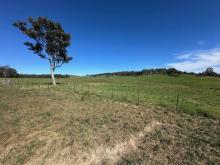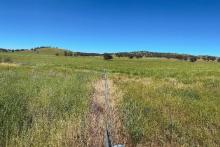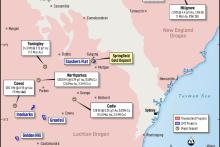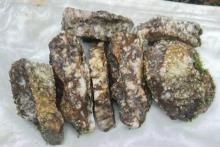Thunderbird Resources’ joint venture partner Mustang Energy has kicked off a 2000m diamond drilling campaign at the duo’s Surprise Creek uranium-copper project in Canada’s Athabasca Basin. The program aims to unlock a high-grade prize at the world’s premier uranium address. Past results at site hit 2.1m at 4.37 per cent uranium, just 57m below surface, and rock chips grading up to 7.98 per cent.


Thunderbird Resources is back on the uranium radar with drills now spinning at its Surprise Creek project in Canada’s famed Athabasca Basin - a region widely considered the world’s number one address for high-grade uranium discoveries.
The company’s joint venture partner Mustang Energy Corporation has pressed green on a 2,000m diamond drilling program to test extensions of a shallow but seriously rich uranium hit that already has the market’s attention. A previous hole at the Surprise Creek fault area lit up with 2.1 metres grading an eye-popping 4.37 per cent uranium from just 57m depth.
Adding to the excitement, surface rock chips collected by Thunderbird from the same area have clocked up assays of up to 7.98 per cent uranium – grades more than enough to quicken the geos pulses. The mineralisation mapped to date already extends along 500m of strike and remains wide open.
Earlier in the year, Thunderbird cut a smart deal that leaves its JV partner Mustang Energy to do the heavy lifting at Surprise Creek. Mustang can lock in a 51 per cent stake simply by dropping C$1 million (A$1.1m) into the ground.
If it wants to crank that up to a commanding 80 per cent, it will then need to splash another C$2 million (A$2.2m) on exploration and hand Thunderbird a combined C$150,000 (A$165k) in cash and shares.
For Thunderbird, the beauty of the deal is clear. it hangs on to a tasty 20 per cent free-carried slice of the action and pockets a handy 2 per cent net smelter royalty, all while Mustang’s drilling dollars drive the discovery hunt.
Thunderbird Resources executive chairman Michael Haynes said: “Surprise Creek is located in the heart of the Athabasca Basin in Canada, the world’s premier uranium province and offers fantastic potential to make a significant high-grade uranium discovery at a time when investor sentiment towards the uranium sector is improving.”
The appetite for uranium has recently surged, fuelled by an improving nuclear power narrative after the market finally shakes off the Fukushima disaster in Japan and as nations hunt low-carbon baseload energy solutions.
Uranium has staged a roaring comeback, with prices up nearly 30 per cent this year to US$83 a pound (A$125/lb) after peaking at US$106/lb (A$160/lb) in 2024. From the dark days of just US$18/lb in 2017, the sector is now trading at heights not seen in two decades - handing well-positioned juniors with real exploration firepower a serious tailwind.
The Athabasca Basin is a monster in the uranium world, having already coughed up some of the globe’s richest deposits including Cameco’s Cigar Lake and McArthur River mines, where grades can tower well into double digits. In this context, Surprise Creek’s shallow high-grade intersections and spicy surface numbers look all the more tantalising.
Meanwhile, Thunderbird has plenty on the plate closer to home as it looks to unearth a new gold and antimony discovery at the company’s Kookabookra project in New South Wales.
Sitting next door to the Hillgrove mine, home to Australia’s biggest antimony prize and owned by fellow ASX-listed Larvotto Resources, Thunderbird has been conducting a geophysical survey across its own ground.
And, it seems, with some success. The study coughed up a series of chargeability anomalies at the company’s Mt Secret and Mannix prospects, potentially laced with sulphides such as pyrite and arsenopyrite.
These types of geophysical highs are often smoking guns for intrusion-related gold systems and appear similar to the style powering the nearby Hillgrove.
On the ground, rock chips from historic mine dumps at the company’s Bear Hill prospect delivered a cracking 17.35 grams per tonne (g/t) gold, with mineralisation hosted in veins and fractures lighting up with arsenopyrite and galena.
Thunderbird then unleashed a light detection and ranging (LiDAR) survey to peel back the terrain and unearth a brand-new target dubbed Kojak. Early sampling didn’t disappoint, serving up grades as high as 23g/t, 5.64g/t, 3.11g/t and 2.88g/t gold, with all seven samples topping 0.1g/t - a clear sign the prospect could be packing some serious punch.
To add to its impressive gold exploration portfolio, Thunderbird has also recently opened its wallet to buy drill-ready Springfield gold deposit 250km south west of Kookabookra in the well renowned Lachlan Belt.
Limited historical drilling of just 6568m has already outlined a 1.7km mineralised intrusion at the project, with standout shallow hits including 27m grading 3.65g/t gold from surface and 65m at 1.16g/t gold from 2m.
Deeper intercepts also impressed, such as 86m going 1.04g/t gold from 104m, including a 12m section grading 2.9g/t gold. With mineralisation still open in all directions and no drilling since 1999, the system looks largely untapped.
Sitting in the same neighbourhood as Newmont’s mighty Cadia mine — home to 14.5 million ounces of gold and 3.2 million tonnes of copper — Thunderbird’s Springfield project carries the hallmarks of a potential blockbuster.
However, with attention immediately focused on uranium in Canada and the drills now cutting core, assays in the weeks ahead will reveal whether Thunderbird and Mustang can take Surprise Creek from a good sniff to a game changing discovery in quick time.
And if those grades keep punching above 4 per cent uranium near surface, Thunderbird and its joint venture partner could quickly become some of the hottest tickets in the uranium boom.
Is your ASX-listed company doing something interesting? Contact: matt.birney@businessnews.com.au













